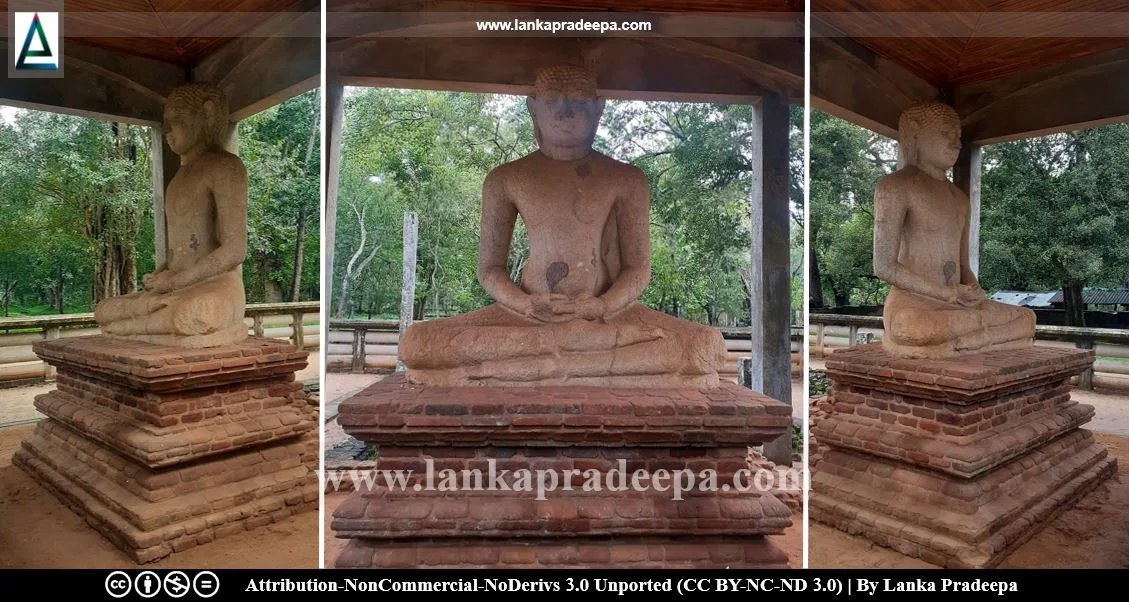
The archaic Buddha image famously known as the Anuradhapura Samadhi Buddha Statue is situated on the wayside of outer circular road (the Watawandana road) between the Kuttam Pokuna and Abhayagiri Stupa in Anuradhapura, Sri Lanka. This statue is considered as one of the finest specimens of Buddha statues in Sri Lanka as well as in the Buddhist world (Jayasuriya, 2016).
History
Sculptured in Gupta style, the statue is supposed to be a creation that belongs to the period between 5-6 centuries A.D. However, the ancient building in which this statue was installed is said to have been erected by King Mahasen [(276-303 A.D.) Uduwara, 1990]. It was later renovated during the reign of King Mahinda IV [(956-972 .D. Uduwara, 1990].
Statue
The statue which is in the Samadhi posture (the posture of deep meditation) and theVirasana (the seat of enlightenment) is completely carved out of stone. The body of the Buddha is covered by a flimsy robe but, it does not cover the right shoulder. The right leg of the statue lies over the left leg and the palms are placed one over the other on the lap. The hair has curls but the Usnisha (the matted lock of hair) is absent (Wikramagamage, 2004). It is said that the original image was a painted statue with inlaid eyes (Jayasuriya, 2016; Wikramagamage, 2004).
The statue was discovered in the present location fallen to the ground with damages to the nose.
Bodhi-tree shrine
Before the construction of image houses, the Buddha statues were usually placed under the shade of a Bodhi-tree. Therefore, it can be assumed that this Samadhi Statue also an example of such an image. Presently, no Bodhi-tree is found at the place but there are signs of a Bodhi-tree that was standing behind the statue. The square-shaped pit where the Bodhi-tree was planted has also been discovered.
The worship of Bodhi tree became prevalent in Sri Lanka after the arrival of Theri Sanghamitta who brought a Sapling of the Bodhi-tree (India) in the 3rd century B.C. (Wijesuriya & Weerasekera, 1997). Within a short time, every temple had its own Bodhi-tree and that led the people to develop and construct a special type of building around the tree called Bodhighara (Wijesuriya & Weerasekera, 1997).
The ruined Bodhighara which has been unearthed near the Samadhi Statue is said to be one of the four ancient Bodhi-tree shrines that belonged to the Abhayagiri monastery complex. Evidence is there to show that this Bodhi-tree shrine had four Buddha statues facing the four cardinal points (Jayasuriya, 2016). Besides the Samadhi Statue, ruins of another Buddha statue (only the portion below the waist) have been found from the site.



.
Attribution
2) This image (SAMADI.PILIMAYA.1870) has been released into the public domain.3) Buddha statue remains, Anuradhapura, Sri Lanka by R Barraez D´Lucca is licensed under CC BY 2.0
4) SRL-anuradhapura-samadi-buddha by Balou46 is licensed under CC BY-SA 3.0
5) Anuradhapura WV banner by Saqib is licensed under CC BY-SA 3.0
References
1) Jayasuriya, E., 2016. A guide to the Cultural Triangle of Sri Lanka. Central Cultural Fund. ISBN: 978-955-613-312-7. pp.30-31.
2) Wijesuriya, G.; Weerasekera, H., 1997. Footprints of our heritage. Sri Lanka National Commission for UNESCO. ISBN: 955-9043-32-3. pp.57,156.
3) Uduwara, J., 1990. Section V: History of the Department of Archaeology: 1970-1990. (Editor in chief: Wijesekara, N.) Archaeological Department Centenary (1890-1990): History of the Department of Archaeology (Vol. 1). Commissioner of Archaeology. p.184.
2) Wijesuriya, G.; Weerasekera, H., 1997. Footprints of our heritage. Sri Lanka National Commission for UNESCO. ISBN: 955-9043-32-3. pp.57,156.
3) Uduwara, J., 1990. Section V: History of the Department of Archaeology: 1970-1990. (Editor in chief: Wijesekara, N.) Archaeological Department Centenary (1890-1990): History of the Department of Archaeology (Vol. 1). Commissioner of Archaeology. p.184.
4) Wikramagamage, C., 2004. Heritage of Rajarata: Major natural, cultural and historic sites. Colombo. Central Bank of Sri Lanka. p.110.
Location Map
This page was last updated on 14 January 2023


